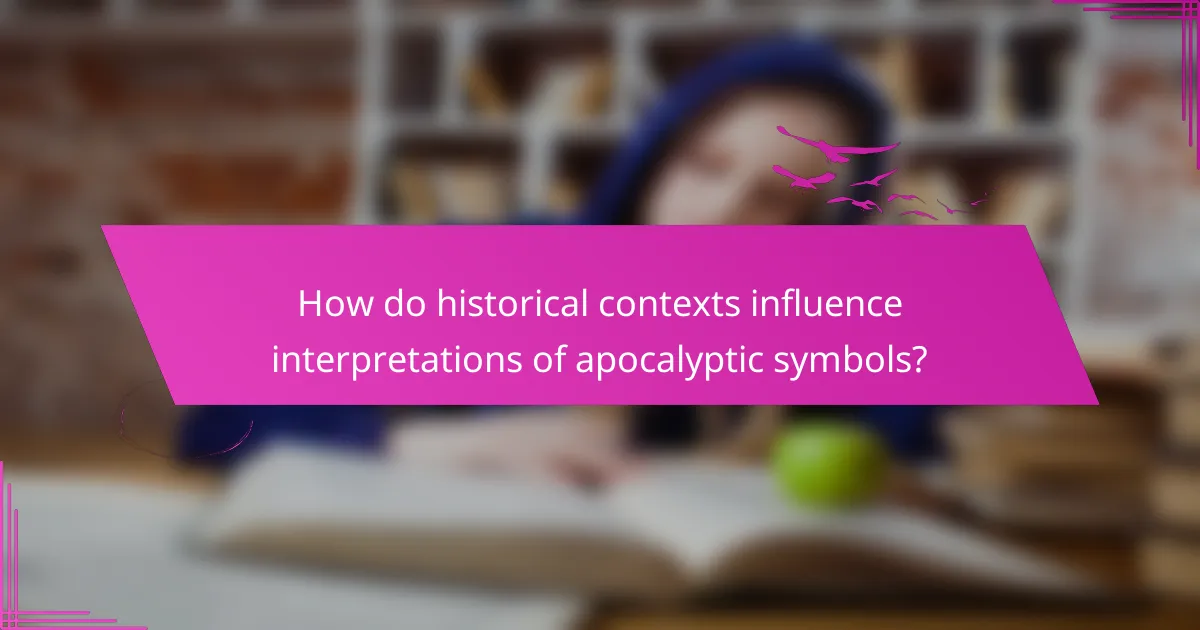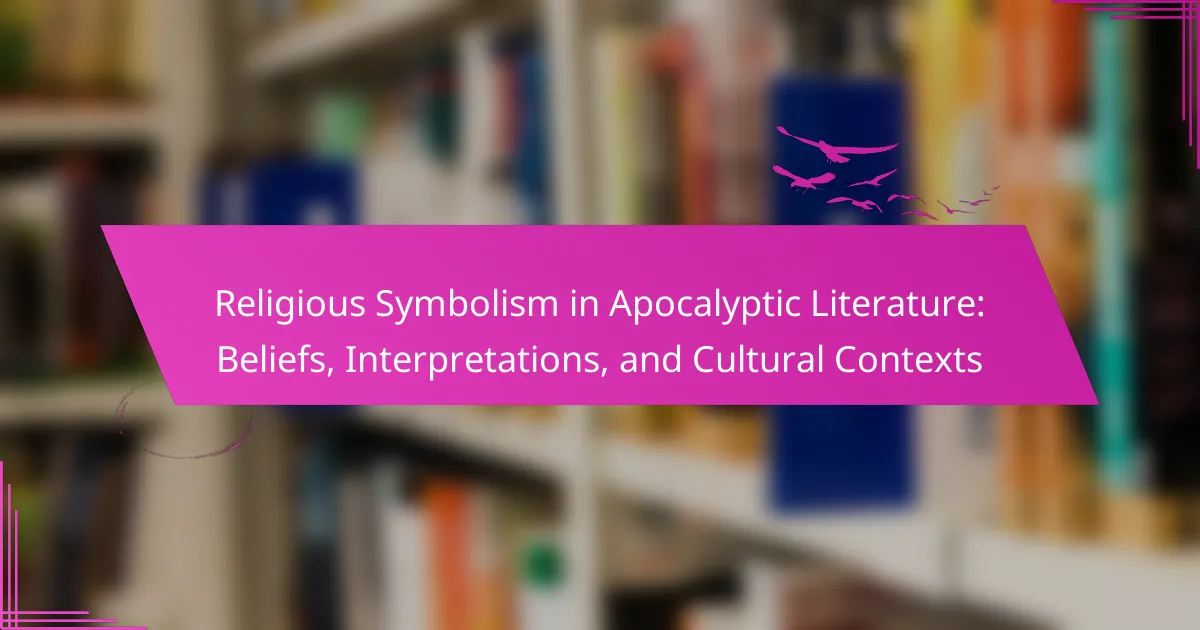Religious symbolism in apocalyptic literature reveals profound insights into human beliefs and societal fears. This article examines key symbols such as the lamb and the beast, explores their cultural contexts, and analyzes historical influences on interpretations. It also highlights unique and rare symbols across various religious texts, including the Four Horsemen and the phoenix, while addressing contemporary reinterpretations that reflect modern anxieties and hopes for transformation.

What are the key themes of religious symbolism in apocalyptic literature?
Religious symbolism in apocalyptic literature often highlights themes of judgment, redemption, and transformation. Key symbols include the lamb, representing sacrifice and purity, and the beast, symbolising chaos and evil. These symbols reflect cultural contexts and beliefs regarding the end times. The use of vivid imagery serves to convey moral lessons and provoke contemplation about faith and the human condition.
How do different cultures interpret apocalyptic symbols?
Different cultures interpret apocalyptic symbols through their unique religious beliefs and historical contexts. For example, in Christianity, symbols like the Four Horsemen represent divine judgment, while in Hinduism, cyclical destruction aligns with cosmic renewal. In Islamic tradition, the Day of Judgment is depicted with vivid imagery of resurrection and accountability. Cultural narratives shape these symbols, influencing interpretations and responses to apocalyptic themes. Understanding these perspectives reveals the diverse meanings attributed to similar symbols across different faiths and cultures.
What role does imagery play in conveying apocalyptic messages?
Imagery plays a crucial role in conveying apocalyptic messages by evoking strong emotional responses and illustrating complex themes. Visual symbols, such as fire, destruction, and celestial phenomena, enhance the dramatic impact of religious texts. These images often reflect cultural fears and hopes, making abstract concepts more relatable. For instance, the imagery of a final judgment resonates deeply with audiences, reinforcing moral teachings and societal values. Additionally, the use of vivid imagery can create a sense of urgency, prompting reflection and action among believers.

Which religious texts prominently feature apocalyptic symbolism?
The Bible, particularly the Book of Revelation, prominently features apocalyptic symbolism. Other significant texts include the Quran, the Book of Daniel, and the Hindu scripture Bhagavad Gita. Each of these works employs vivid imagery to convey messages about the end times, divine judgment, and the ultimate triumph of good over evil. The symbolism serves to inspire hope and provoke reflection on moral and ethical issues within their respective cultural contexts.
How does the Book of Revelation utilize symbolism?
The Book of Revelation employs symbolism to convey complex spiritual truths and prophetic messages. Symbolic imagery, such as the Beast and the New Jerusalem, represents deeper meanings about faith, judgment, and divine hope. This use of symbolism allows readers to interpret the text within various cultural and theological contexts. For example, the number seven often signifies completeness, reflecting the divine order in God’s creation. Additionally, the vivid metaphors engage the audience, prompting reflection on moral and ethical implications.
What symbols are found in the Quran’s apocalyptic references?
The Quran’s apocalyptic references include symbols such as the Day of Judgment, scales of justice, and the bridge over Hell. These symbols convey the themes of accountability, divine judgment, and the afterlife. They serve to illustrate moral and ethical teachings within the Islamic faith, emphasizing the importance of righteous behaviour. The imagery of fire and gardens signifies the ultimate fate of souls, reinforcing the belief in an eternal afterlife.

How do historical contexts influence interpretations of apocalyptic symbols?
Historical contexts significantly shape interpretations of apocalyptic symbols by influencing cultural beliefs and societal fears. Different eras perceive symbols through the lens of their unique challenges and aspirations. For instance, symbols of destruction may resonate with societies facing warfare or natural disasters, while symbols of renewal might reflect periods of hope and recovery. The interpretation of these symbols can vary widely, reflecting the values and experiences of the time. This dynamic interplay demonstrates how historical events and prevailing ideologies enrich the understanding of religious symbolism in apocalyptic literature.
What impact did the Roman Empire have on early Christian apocalyptic literature?
The Roman Empire significantly influenced early Christian apocalyptic literature by shaping its themes and symbols. The empire’s political and cultural context introduced concepts of divine judgment and cosmic struggle. Early Christians often used apocalyptic imagery to critique Roman authority and express hope for divine intervention. This literature reflected a unique attribute of resistance against oppression while incorporating familiar symbols from Roman culture. As a result, early Christian texts like the Book of Revelation employed vivid imagery to convey messages of faith, perseverance, and ultimate victory over evil.
How did the Reformation shape views on apocalyptic symbolism?
The Reformation significantly transformed views on apocalyptic symbolism by emphasizing individual interpretation of scripture. This shift led to diverse beliefs regarding the end times, often reflecting contemporary social and political issues.
Protestant reformers like Martin Luther and John Calvin encouraged believers to seek personal understanding of biblical texts, including the Book of Revelation. As a result, apocalyptic imagery became intertwined with calls for reform and critiques of established authority.
Unique interpretations emerged, such as the idea of the Antichrist representing the Catholic Church, which fueled tensions and shaped religious discourse. The Reformation’s focus on personal faith also democratized access to apocalyptic themes, allowing laypeople to engage with these symbols in ways previously reserved for clergy.
Overall, the Reformation’s impact on apocalyptic symbolism illustrates a broader cultural shift towards individualism in religious thought, creating a legacy that continues to influence interpretations today.

Which unique symbols are associated with specific apocalyptic narratives?
Unique symbols associated with specific apocalyptic narratives include the Four Horsemen of the Apocalypse, representing conquest, war, famine, and death. The number 666 symbolizes the Beast in Christian eschatology. In Hinduism, the conch shell signifies the call to arms for the final battle of good versus evil. The phoenix represents rebirth in various cultures, symbolising renewal after destruction. The serpent often embodies chaos and temptation, appearing in multiple apocalyptic contexts. Each symbol carries distinct interpretations and cultural significance, reflecting the beliefs surrounding end-times scenarios.
What is the significance of the Four Horsemen in Christian eschatology?
The Four Horsemen symbolize conquest, war, famine, and death in Christian eschatology, representing the trials preceding the end times. Their significance lies in illustrating humanity’s struggles and divine judgment. Each horseman embodies a unique attribute of apocalyptic events, highlighting moral and spiritual lessons. This imagery has influenced cultural interpretations, emphasizing the urgency of faith and repentance in the face of impending judgment.
How does the concept of the Antichrist vary across religions?
The concept of the Antichrist varies significantly across religions, reflecting diverse beliefs and interpretations. In Christianity, the Antichrist is often seen as a singular figure opposing Christ, embodying evil and deception. In Islam, the Dajjal represents a false messiah, leading people astray before the Day of Judgment. Judaism does not have a direct equivalent but anticipates a messianic age where false prophets may arise. In Gnosticism, the Antichrist symbolizes ignorance and materialism, contrasting with spiritual enlightenment. These varying depictions illustrate the cultural contexts influencing apocalyptic literature and religious symbolism.

What rare symbols appear in lesser-known apocalyptic texts?
Rare symbols in lesser-known apocalyptic texts include the serpent, the phoenix, and the hourglass. These symbols convey complex themes of rebirth, time, and transformation. The serpent often represents deception and wisdom, while the phoenix signifies renewal through destruction. The hourglass illustrates the passage of time and impending judgment. Each symbol carries unique interpretations across various cultures, enriching the understanding of apocalyptic narratives.
How do indigenous apocalyptic beliefs manifest in their symbolism?
Indigenous apocalyptic beliefs manifest in their symbolism through rich imagery and narratives reflecting cultural values. These symbols often represent renewal, transformation, and the cyclical nature of life. For instance, the use of natural elements like fire and water signifies purification and rebirth. Unique attributes, such as the specific animal totems or celestial bodies, further differentiate these beliefs among various tribes. The symbolism serves as a means to convey moral lessons and communal identity, reinforcing the connection to ancestral traditions.
What unique interpretations arise from the Nag Hammadi library texts?
Unique interpretations from the Nag Hammadi library texts emphasize alternative views of creation, knowledge, and the divine. These texts challenge traditional religious narratives, presenting a Gnostic perspective that values personal spiritual insight. For instance, the concept of the Demiurge highlights a flawed creator, which contrasts with mainstream beliefs about a perfect God. Additionally, the texts explore the significance of gnosis, or knowledge, as a means to salvation, diverging from faith-based doctrines. This reinterpretation influences contemporary discussions on spirituality and the nature of the divine.

How do contemporary movements interpret apocalyptic symbolism?
Contemporary movements interpret apocalyptic symbolism as a reflection of societal anxieties and hopes for transformation. Many view these symbols as metaphors for personal and collective change, often aligning them with current issues like climate change or social justice.
Movements such as environmentalism utilize apocalyptic imagery to highlight the urgency of ecological crises. This interpretation emphasizes a call to action, suggesting that humanity stands at a crossroads. Similarly, social justice movements adopt apocalyptic themes to critique systemic injustices, portraying the potential for societal rebirth through upheaval.
Religious groups often reinterpret traditional apocalyptic texts to resonate with modern experiences. For instance, some Christian denominations emphasize hope and redemption in their readings, contrasting with more fear-driven interpretations. This shift reflects a unique attribute of contemporary spirituality, focusing on empowerment rather than despair.
Overall, contemporary interpretations of apocalyptic symbolism reveal a complex interplay between fear, hope, and the desire for renewal, illustrating how these ancient motifs adapt to address modern realities.
What role do modern media play in shaping apocalyptic narratives?
Modern media significantly shape apocalyptic narratives by amplifying religious symbolism and cultural interpretations. They influence public perception through various formats, including films, books, and social media. These platforms often blend traditional beliefs with contemporary fears, creating unique interpretations of apocalyptic themes. For instance, modern adaptations of religious texts can highlight societal anxieties while maintaining core symbolic elements. This interplay between media and religious narratives fosters a dynamic cultural context that evolves with audience engagement.
How do environmental concerns influence current apocalyptic themes?
Environmental concerns significantly shape contemporary apocalyptic themes by reflecting societal anxieties about climate change and ecological collapse. These themes often manifest in literature and media, illustrating fears of environmental degradation and its consequences.
Religious symbolism in apocalyptic literature frequently intertwines with these concerns, portraying environmental disasters as divine messages or warnings. For example, floods and droughts are depicted as manifestations of divine judgment, emphasizing the moral implications of humanity’s relationship with nature.
Moreover, cultural contexts influence interpretations of these themes, as different societies may attribute varying meanings to environmental crises. In some cultures, such crises are seen as opportunities for redemption and renewal, while others view them as inevitable doom.
This intersection of environmental issues and apocalyptic narratives highlights humanity’s struggle to reconcile faith, responsibility, and the urgent need for sustainable practices.

What best practices can enhance the understanding of religious symbolism in apocalyptic literature?
To enhance understanding of religious symbolism in apocalyptic literature, focus on historical context, cultural interpretations, and intertextual connections.
Analyzing the socio-political environment of the time can reveal how symbolism was shaped. For example, understanding the Roman Empire’s influence on early Christian texts can clarify certain symbols.
Engaging with diverse interpretations from various religious traditions enriches the analysis. This approach highlights the multifaceted nature of symbols, revealing how they resonate differently across cultures.
Utilizing comparative literature techniques can illuminate common themes and symbols in apocalyptic texts. This method allows for a deeper exploration of how similar motifs manifest in different religious contexts.
How can interdisciplinary approaches enrich the study of apocalyptic texts?
Interdisciplinary approaches enhance the study of apocalyptic texts by integrating diverse perspectives and methodologies. These collaborations reveal deeper meanings and cultural contexts within religious symbolism. For example, literary analysis can uncover narrative structures while theological studies provide insights into belief systems. Additionally, historical perspectives contextualize the texts within their societal frameworks. This multifaceted examination enriches interpretations and fosters a comprehensive understanding of apocalyptic literature.
What common mistakes should be avoided when interpreting apocalyptic symbols?
Avoiding common mistakes in interpreting apocalyptic symbols requires careful consideration of context and intent. Misinterpretation often arises from taking symbols too literally or ignoring cultural backgrounds. Contextual analysis is crucial; symbols may vary in meaning across different religious traditions. Additionally, overemphasis on sensationalism can lead to skewed interpretations. Recognizing the symbolic nature of these texts helps prevent simplistic readings. Engaging with scholarly interpretations can provide deeper insights and mitigate personal biases.
